The Micron 6500 ION NVMe SSD is the first 200+ layer data center SSD that aims to offer affordable and scalable storage. Available in a single 30.72TB capacity, the 6500 ION comes in a 15mm U.3 and E1.L form factor. The drive explicitly aims to disrupt the Solidigm P5316 in the enterprise, which has been shipping in a 30.72TB capacity for some time at a lower cost than TLC SSDs. The 6500 ION changes that math; however, Micron says the 6500 ION will be price comparable with the P5316 at the 30.72TB capacity point.
The Micron 6500 ION NVMe SSD is the first 200+ layer data center SSD that aims to offer affordable and scalable storage. Available in a single 30.72TB capacity, the 6500 ION comes in a 15mm U.3 and E1.L form factor. The drive explicitly aims to disrupt the Solidigm P5316 in the enterprise, which has been shipping in a 30.72TB capacity for some time at a lower cost than TLC SSDs. The 6500 ION changes that math; however, Micron says the 6500 ION will be price comparable with the P5316 at the 30.72TB capacity point.

This drive is not Micron’s first 30.72TB NVMe SSD rodeo, they recently launched the Micron 9400 Pro, and we enjoyed that drive for its overall performance and density story. While the 9400 Pro is designed for high-performance enterprise applications, the 6500 ION is designed for high-capacity use cases where overall system cost is an issue and data availability and improved performance, density, and power consumption over HDD arrays. It’s not just the drive price and target use case; underneath the covers, the two SSDs are completely different, including controllers, NAND, and firmware optimization.

Nonetheless, the Micron 6500 ION boasts a solid quoted performance profile. It claims to achieve a sequential read speed of 6,800MB/s and a sequential write speed of 5,000MB/s while touting random 4KB read and write performance of 1,000,000 IOPS and 200,000 IOPS, respectively. In terms of endurance, the Micron 6500 ION drive is advertised with an endurance rating of 0.3 RDWPD (Reads + Writes Per Day), which translates to a potential daily usage of 9TB. As for reliability, the drive claims a rating of 2.5 million device hours. These specifications show that it is undoubtedly well-suited to withstand demanding workloads and deliver consistent performance over an extended lifespan.
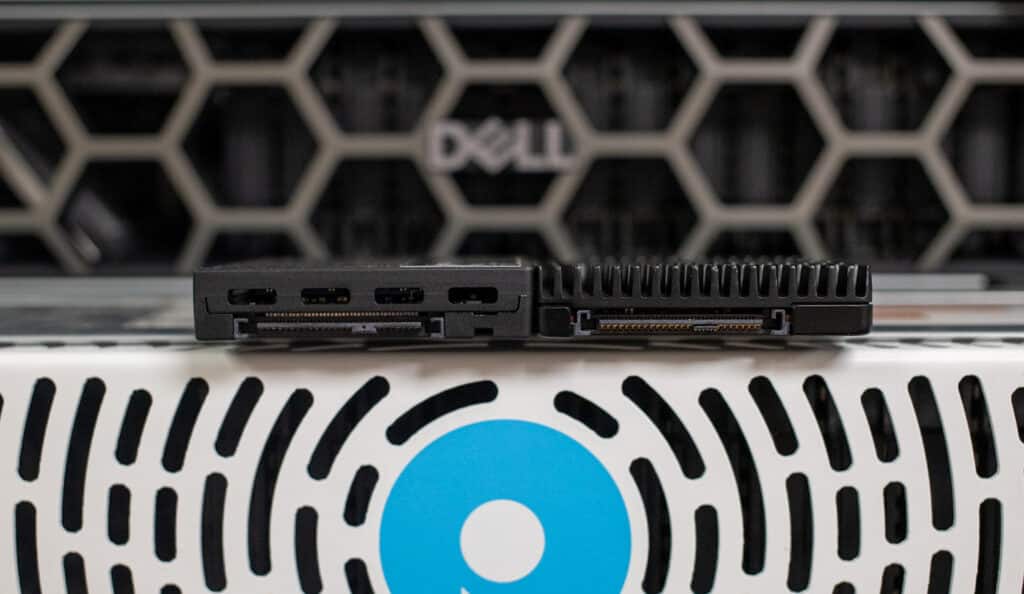
Backed by a 5-year warranty, the Micron 6500 ION SSD will be available to channel partners and global OEM customers on May 30, 2023.

Micron 6500 ION Specifications
| NAND | Micron 232 layer TLC NAND: 14.55Gb/mm |
| Interface | PCIe Gen4 1×4 NVMe (v2.0) |
| Security |
|
| Sequential reads | 6,800MB/s |
| Sequential writes | 5,000MB/s |
| Random 4KB reads | 1,000,000 IOPS |
| Random 4KB writes | 200,000 IOPS |
| Random 4KB read avg. QoS | 70µs |
| Active power | 20W |
| Endurance |
100% 128KB Sequential Writes – 1.0 DWPD (30TB per day) 100% 4KB Random Writes – 0.3 DWPD (9TB per day) 90% 128KB Sequential Write / 10% 4KB Random Write – 0.9 DWPD (27TB per day) 80% 128KB Sequential Write / 20% 4KB Random Write – 0.85 DWPD (26TB per day) 70% 128KB Sequential Write / 30% 4KB Random Write – 0.75 DWPD (23TB per day) 50% 128KB Sequential Write / 50% 4KB Random Write – 0.55 DWPD (16TB per day) |
| Reliability | 2.5 million device hours |
| Warranty | 5 years |
Micron 6500 ION Performance
Testbed
Our PCIe Gen4 Enterprise SSD reviews leverage a Lenovo ThinkSystem SR635 for application tests and synthetic benchmarks. The ThinkSystem SR635 is a well-equipped single-CPU AMD platform, offering CPU power well over what’s needed to stress high-performance local storage. Synthetic tests don’t require a lot of CPU resources but still leverage the same Lenovo platform. In both cases, the intent is to showcase local storage in the best light possible that aligns with storage vendor maximum drive specs.
PCIe Gen4 Synthetic and Application Platform (Lenovo ThinkSystem SR635)
- 1 x AMD 7742 (2.25GHz x 64 Cores)
- 8 x 64GB DDR4-3200MHz ECC DRAM
- CentOS 7.7 1908
- ESXi 6.7u3
VDBench Workload Analysis
When it comes to benchmarking storage devices, application testing is best, and synthetic testing comes in second place. While not a perfect representation of actual workloads, synthetic tests help baseline storage devices with a repeatability factor that makes it easy to make apples-to-apples comparisons between competing solutions. These workloads offer a range of testing profiles ranging from “four corners” tests and common database transfer size tests to trace captures from different VDI environments.
All of these tests leverage the common vdBench workload generator, with a scripting engine to automate and capture results over a large compute testing cluster. This allows us to repeat the same workloads across a wide range of storage devices, including flash arrays and individual storage devices. Our testing process for these benchmarks fills the entire drive surface with data and then partitions a drive section equal to 25% of the drive capacity to simulate how the drive might respond to application workloads. This differs from full entropy tests, which use 100 percent of the drive and takes them into a steady state. As a result, these figures will reflect higher-sustained write speeds.
Profiles:
- 4K Random Read: 100% Read, 128 threads, 0-120% iorate
- 4K Random Write: 100% Write, 128 threads, 0-120% iorate
- 64K Sequential Read: 100% Read, 32 threads, 0-120% iorate
- 64K Sequential Write: 100% Write, 16 threads, 0-120% iorate
- 64K Random Read: 100% Read, 32 threads, 0-120% iorate
- 64K Random Write: 100% Write, 16 threads, 0-120% iorate
- Synthetic Database: SQL and Oracle
- VDI Full Clone and Linked Clone Traces
In this review, we’re looking at high-capacity SSDs, including the Micron 9400 Pro and the Solidigm P5316. We typically don’t compare TLC and QLC products, but since Micron has made it clear they intend to offer the 6500 ION at the same price as the P5316, we’ve mapped them against each other in this review. The 9400 Pro is included primarily as an in-brand reference to show where the Micron portfolio can scale in terms of large-capacity SSDs.
In our first VDBench Workload Analysis, random 4K read, the Micron 6500 ION had a peak performance of 1.06 million IOPS at a latency of 483.1µs. This placed it behind the Micron 9400 Pro but solidly in front of the Solidigm P5316.
 In 4K random write, the 6500 ION had a peak of 482K IOPS with a latency of 1,053µs. This performed much better than the Solidigm drive and about half of the 9400 Pro.
In 4K random write, the 6500 ION had a peak of 482K IOPS with a latency of 1,053µs. This performed much better than the Solidigm drive and about half of the 9400 Pro.
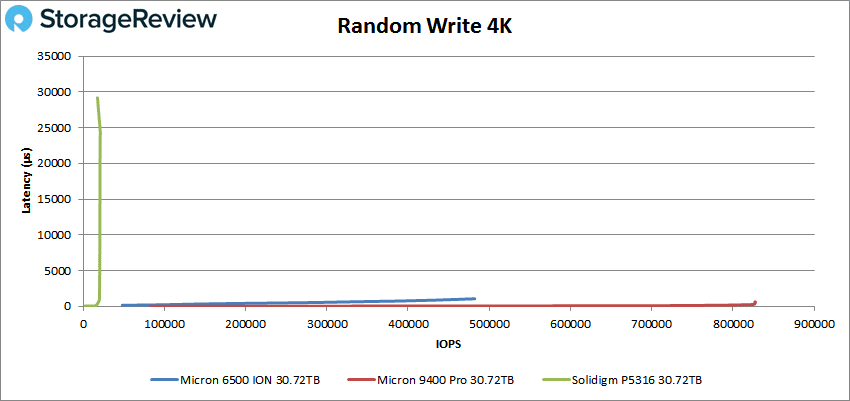
Switching over to 64k sequential workloads, the 6500 ION fell back a bit (behind both drives) in 64K write, peaking at 5.1GB/s (81K IOPS) with a latency of 788.9µs.

In writes, the 6500 ION posted 3.2GB/s write (51K IOPS) at 1,246µs in latency, giving it a commanding lead over the P5316.

Next is our 64K random performance, where the new Micron drive posted 73K IOPS or 4.5GB/s and 437.5µs in latency. This came in behind the Solidigm P5316 in terms of peak bandwidth.

In writes, the 6500 ION peaked at 51K IOPS or 3.2GB/s with 303.7µs in latency, compared to the Solidigm P5316, measuring 522MB/s.

Our next set of tests is our SQL workloads: SQL, SQL 90-10, and SQL 80-20, all of which showed solid results. Starting with SQL, the 6500 ION posted a peak performance of 305K with a latency of 103.7µs.

In SQL 90-10, the new Micron drive showed a peak performance of 301K with a latency of 104.9µs.

With SQL 80-20, the Micron 6500 ION peaked at 299K IOPS at a latency of 105.3µs, again trailing just the 9400 Pro.
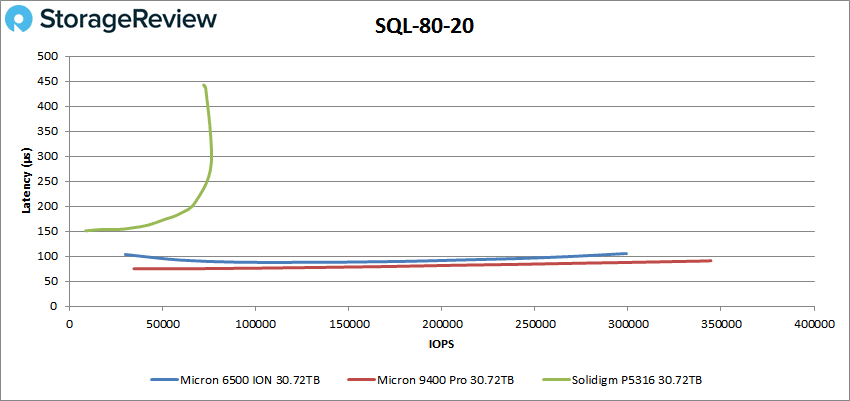
Next up are our Oracle workloads: Oracle, Oracle 90-10, and Oracle 80-20. As with the SQL benchmarks, the Micron 6500 ION continued to take second place with solid numbers. Starting with the general Oracle workload, the Micron drive had a peak performance of 300K IOPS at 117.1µs.
 Looking at Oracle 90-10, the 6500 ION posted a peak performance of 229K IOPS at 94.5µs.
Looking at Oracle 90-10, the 6500 ION posted a peak performance of 229K IOPS at 94.5µs.

Next is Oracle 80-20, where the 6500 ION peaked at 236K IOPS at 91.3µs, just trailing the 9400 Pro.
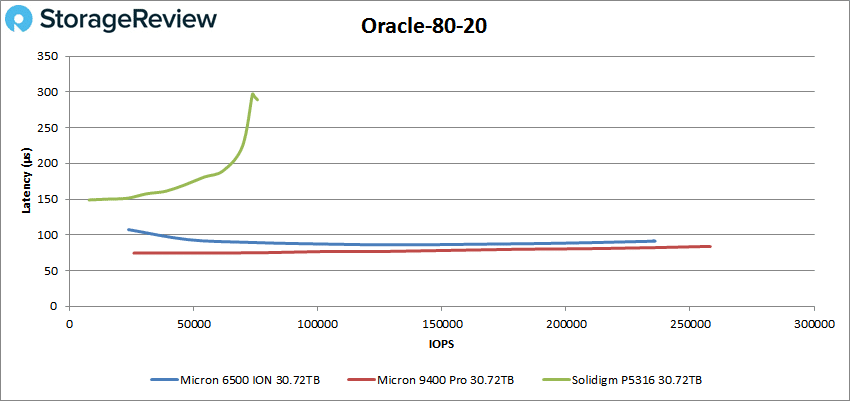
Next, we switched to our VDI clone test, Full and Linked, where the 6500 ION continued its solid performance. VDI Full Clone (FC) Boot peaked at 230K IOPS with a latency of 109.1µs.

During VDI FC Initial Login, the ION peaked at 163K IOPS with a latency of 180.8µs. Again, the Solidigm drive was well back of the two Micron drives.

With VDI FC Monday Login, the Micron 6500 ION posted 117K IOPS at a latency of 123µs.
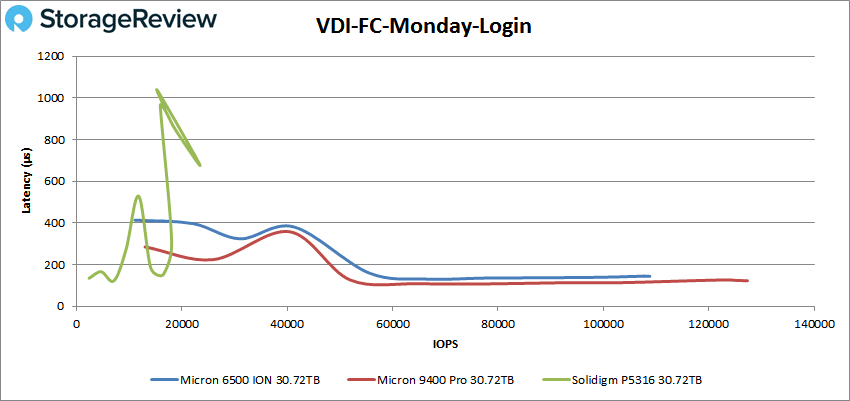
For VDI Linked Clone (LC) Boot, the 6500 ION showed a peak of 98K IOPS with 161.5µs.
 In VDI LC Initial Login, the 6500 ION finally showed some severe instability (like the other two tested drives). With the smaller block sizes in this workload profile, the larger capacity drives have a lot of trouble handling them in a stable manner. Here, it peaked at 19K IOPS at roughly 100µs before also taking a huge hit in performance. It ended the test at 11K IOPS at around the 700µs mark.
In VDI LC Initial Login, the 6500 ION finally showed some severe instability (like the other two tested drives). With the smaller block sizes in this workload profile, the larger capacity drives have a lot of trouble handling them in a stable manner. Here, it peaked at 19K IOPS at roughly 100µs before also taking a huge hit in performance. It ended the test at 11K IOPS at around the 700µs mark.

VDI LC Monday Login took a considerable performance spike while approaching 25K IOPS and ended the test at 15K IOPS at 1,032µs.

Final Thoughts
The Micron 6500 ION NVMe SSD stands out as an innovative storage solution designed to thrive in data centers thanks to its capacity and cost profile. It distinguishes itself by being the first SSD of its kind with over 200 layers, offering scalable and cost-effective storage options for data centers and other similar environments. With a capacity of 30.72TB and availability in both 15mm U.3 and E1.L form factors, this enterprise SSD aims to impact the market in a significant way with a clear plan to disrupt the Solidigm P5316’s leadership in the value, high-capacity space.
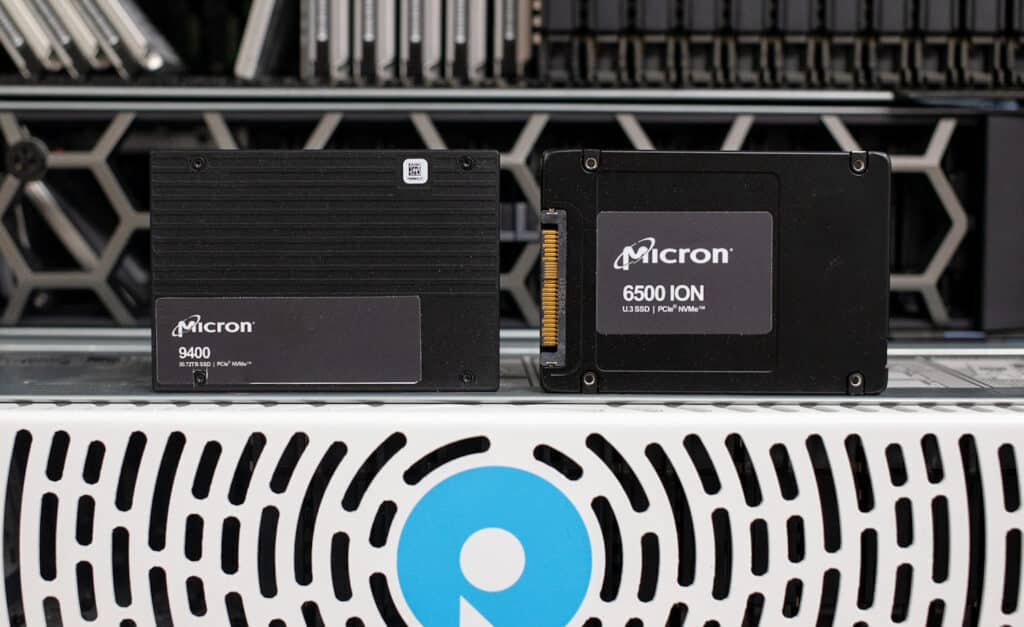
That said, while Micron has previously introduced the Micron 9400 Pro as a high-performance SSD, the 6500 ION takes a different approach. It is designed to address the needs of environments where overall system cost is a significant factor, emphasizing data availability, improved performance, density, and power consumption compared to traditional HDD arrays. Under the hood, the 6500 ION also differentiates itself from the 9400 Pro through various components, including distinct controllers, NAND, and firmware optimizations.
Looking at its performance results, the Micron 6500 ION has a commanding lead over the Solidigm P5316 at the same capacity point. While the 64K write indirection unit limits the write performance of the QLC-based P5316, the Micron 6500 ION had no issues keeping up performance across a wide range of workloads. This gives it a unique advantage where application developers may not need to significantly overhaul the I/O backend of software that isn’t completely tuned for QLC devices.
Overall the Micron 6500 ION is an overpowering competitor to the Solidigm P5316 QLC SSD, aiming to come in at lock-step pricing; it offers TLC performance with a QLC sticker price. As we saw across almost all of our workloads, it had no trouble handling the P5316. With that said, there has been no price competition against the P5316 up to this point, so none of us know how low the price floor is that Solidigm is willing to push. Our hunch is that the 6500 ION has less margin to work with, so it will be interesting to watch this showdown unfold. Whatever the outcome, the industry wins, with more drives getting bigger, faster, and more cost-effective. For its part, the Micron 6500 ION is a fantastic drive and a good portfolio expansion piece for the company.

Engage with StorageReview
Newsletter | YouTube | Podcast iTunes/Spotify | Instagram | Twitter | TikTok | Discord | RSS Feed

